| Pages:
1
2 |
CES Scientist
Harmless

Posts: 1
Registered: 25-11-2010
Member Is Offline
Mood: No Mood
|
|
How to make Carbon Tetrachloride
Carbon Tetrachloride is just another chemical the EPA has restricted it use. For an Amateur Chemist it is hard and expensive to come by. But if you
are willing to sacrifice a little Chloroform (CHCl3) it can be easly made.
By bubbling Chlorine gas though the CHCl3. What you will get is a yellow liquid of Carbon Tetrachloride and Hydrochloric Acid (CHCl3 + Cl2 = CCl4 +
HCl). Now to get rid of the Hydrochloric Acid add equal parts of water, shack to dissolve the Acid in the water. The CCl4 which is lighter than the
water will float. You can now carefully remove the Carbon Tetrachloride from the top with an eyedropper.
[Edited on 25-11-2010 by CES Scientist]
|
|
|
mnick12
Hazard to Others
  
Posts: 404
Registered: 30-12-2009
Location: In the lab w/ Dr. Evil
Member Is Offline
Mood: devious
|
|
I don't think that will work, the chlorination methane and it's halogenated friends is almost always accomplished by a free-radical reaction. Which is
usually created by a combination of UV and heat, I doubt simply bubbling Cl gas through chloroform will get you any detectable amount of CCl4.
Also the density of carbon tet. is 1.5867 g/cm3, and water is 1.0g/cm3, so it will sink not float!
Anyway welcome!
|
|
|
hissingnoise
International Hazard
    
Posts: 3940
Registered: 26-12-2002
Member Is Offline
Mood: Pulverulescent!
|
|
It's not just for the environment's sake - C-tet is carcinogenic and highly toxic . . .
Think about safety measures before attempting its preparation!
|
|
|
bbartlog
International Hazard
    
Posts: 1139
Registered: 27-8-2009
Location: Unmoored in time
Member Is Offline
Mood: No Mood
|
|
Seems unlikely to work without a good dose of sunlight to give you Cl- radicals (or a catalyst perhaps). Got a reference?
Even then, you would end up with some residual CHCl3, which you don't suggest any way of separating (the HCl, on the other hand, might well just gas
off, with the residue easily neutralized by something like CaCO3). Fractional distillation seems like it would be called for. I suppose it depends on
what you are planning to use the CCl4 for.
| Quote: | | The CCl4 which is lighter than the water will float. You can now carefully remove the Carbon Tetrachloride from the top with an eyedropper.
|
So you haven't actually tried this; if you had a source for this, you couldn't be bothered to include a reference to it; and even checking up the
densities of these compounds before posting was just too much trouble to go to.
FWIW here is Regnault (discoverer of CCl4), writing in 1853 (Elements of Chemistry vol 2), emphasis mine:
'Chloroform, subjected to the action of chlorine, in the light of the sun, until chlorohydric acid is no longer disengaged, loses its
last equivalent of hydrogen...' (etc.)
|
|
|
chemoleo
Biochemicus Energeticus
    
Posts: 3005
Registered: 23-7-2003
Location: England Germany
Member Is Offline
Mood: crystalline
|
|
FRom what I hear from the professional chemists, CCl4 isn't actually *that* toxic - they used it for rinsing/cleaning glassware!
Even DMF has nowadays a toxic sticker on it - and again it isn't actually that toxic!
The health and safety people are becoming over zealous, they are crying too many times 'wolf' and in the end we end up with NaCl being toxic and
believing it- and in fact it is, if you eat enough!
In any case, the consensus is clear in that this is written like a procedure, which actually can't work as such, unless when performed with UV, etc.
[Edited on 26-11-2010 by chemoleo]
Never Stop to Begin, and Never Begin to Stop...
Tolerance is good. But not with the intolerant! (Wilhelm Busch)
|
|
|
chemoleo
|
Thread Moved
25-11-2010 at 15:34 |
garage chemist
chemical wizard
    
Posts: 1803
Registered: 16-8-2004
Location: Germany
Member Is Offline
Mood: No Mood
|
|
It can be done in the liquid phase, using either direct sunlight or iodine chloride or antimony trichloride as catalyst.
Iodine chloride is formed in situ from iodine, so all you need is some iodine as the essential catalyst to make CCl4 from CHCl3 in the lab.
Attached is the german prep for CCl4 from CHCl3 and chlorine.
In essence, bubble chlorine into pure chloroform (in a RBF with reflux condenser) containing some iodine until no further HCl is evolved (e.g. when
the offgas is pure chlorine and no longer fumes in air).
Then free the liquid from excess chlorine using a NaOH(aq) wash (they shake with Hg metal to accomplish the Cl2 removal, probably a standard technique
in 1937), dry with CaCl2 and fractionally distill from a water bath.
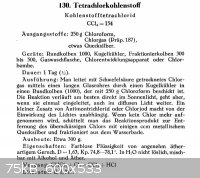
|
|
|
len1
National Hazard
   
Posts: 595
Registered: 1-3-2007
Member Is Offline
Mood: NZ 1 (goal) - Italy 1 (dive)
|
|
I find you need a 2x molar excess of Cl2 in UV light for complete conversion (> 99.9%).
However I would querry this articles suggestion that iodine can replace UV. Thompson states that the much more aggressive SbCl5 is needed, and
preceeds this with the acknowledgement that nothing can beat chlorination in sunlight, SbCl5 leads to longer reaction time, more impurities and
certainly incomplete chlorination.
Reaction rate goes as the square root of I. In the UV light is attenuated far more than in the visible (fewer things transmit/reflect UV well).
Hence UV will be a factor of 100 or more down in diffuse than in direct sunlight - and the reaction rate will be 10 times slower. Since the article's
authors consider this acceptable I presume this is about the rate you get with iodine (if not less)
Now the actual absolute values. Chlorination in a 1L flask at 1kW UV takes about 1hr/mole. The sun straight ahead is 1kW/m^2, or 10W for a 1L flask -
about 5% of thus is blue/UV. So the reaction in bright sunlight is about 0.1mole/hr. In diffuse light this is 0.01mole/hr and a complete waste of
time, since CCl4 and CHCl3 are hard to fractionate.
[Edited on 26-11-2010 by len1]
|
|
|
Jor
National Hazard
   
Posts: 950
Registered: 21-11-2007
Member Is Offline
Mood: No Mood
|
|
Carbon tetrachloride is not that toxic, it is however one of the more toxic solvents, but I think you can safely work with it provided effective
ventilation.
However it can be extremely toxic to in combination with alcohol, or chronic alcohol addicts. I think I read somewhere that in a investigation on the
toxicity, a group of people where exposed for 15 minutes to 250ppm CCl4. All of them had no to minor effects, but one alcoholic died from liver
necrosis (wich means that it was more acutely toxic than chlorine to him). So when you drink lots of alcohol i recommend to work much more carefully.
Ofcourse when under influence you shouldn't experiment at all (in my opinion, unless it's 1-2 drinks).
However, the reason it is completely banned (together with another solvent, 1,1,1-trichloroethane, wich is not nearly as toxic), is it's ozone
depleting property.
I was wondering, can chloroform be removed from the mixture of CCl4 and CHCl3, by washing with base? NaOH-solution should deprotonate the chloroform,
extracting the CCl3(-) anion. However, I recall this decomposes tot dichlorocarbene and chloride. Is this dangerous? Maybe something could be added,
to immediately react with the .CCl2 radical once formed.
GC have you actually tried this method? Or anyone else had. Would be nice to hear your experiences. Not to make it however, I already have a nice
350ml of pure CCl4. I even have less chloroform than CCl4 so it would make no sense making CCl4 from it. 
[Edited on 27-11-2010 by Jor]
|
|
|
garage chemist
chemical wizard
    
Posts: 1803
Registered: 16-8-2004
Location: Germany
Member Is Offline
Mood: No Mood
|
|
No, I haven't tried this, as I also have enough CCl4, and rarely use it since in many of its uses (bromination and chlorination solvent) it can be
replaced by chloroform or DCM.
But the text is from a collection of inorganic textbook preparations, so there is some reason to believe that it should work.
|
|
|
bbartlog
International Hazard
    
Posts: 1139
Registered: 27-8-2009
Location: Unmoored in time
Member Is Offline
Mood: No Mood
|
|
Interesting... I wouldn't have thought that aqueous NaOH would significantly attack CHCl3 under normal conditions (close to RT), but apparently it
does (see e.g. http://www.orgsyn.org/orgsyn/orgsyn/prepContent.asp?prep=cv6...). Now granted, they use a phase transfer catalyst. This might be something to
account for next time I use the haloform reaction to generate CHCl3, since the NaOH present will apparently decompose some of the product.
As a way of purifying the product, though... seems like it has complications. I expect you would want the PTC in order to have any chance of getting
substantially all of the CHCl3 reacted, and then as you suggest I think some scavenger for the dichlorocarbene. So then you need to distill once
again. Probably easier to just go for chlorination overkill and try to get as much of the CHCl3 reacted as possible in the beginning.
|
|
|
Magpie
lab constructor
    
Posts: 5939
Registered: 1-11-2003
Location: USA
Member Is Offline
Mood: Chemistry: the subtle science.
|
|
Len1, in his book "Small-Scale Synthesis of Laboratory Reagents," shows how he converted chloroform to carbon tetrachloride in near quantitative yield
using free radical chlorination. This post will document my efforts to do the same using a scaled down version of Len's method.
Len used a charge of 239g of chloroform and a 1kW mercury vapor lamp. In each of my two experiments I used a charge of 149g (100mL) and a 0.1kW
mercury vapor lamp.
My chloroform was reagent grade. The mercury vapor lamp was from a yard security light. This lamp, I assume, uses a "high pressure" (~1 atm) mercury
vapor arc in a quartz tube. In the first experiment I used the lamp as is, ie, I did not remove the outer borosilicate glass protective envelope.
Upon some research I learned that the UV light needed to generate the free radicals does not pass this outer envelope. According to a borosilicate
glass technical reference the chlorine molecule absorbs in the 280-400 nm range. So, using a Dremel tool with a diamond cut-off wheel I removed this
outer envelope exposing the bare arc tube. This arc tube is what I used for the second experiment. One must remember that exposure to UV in
this range can result in sunburn and retina damage.The picture below shows the lamp after removal of the outer protective envelope:
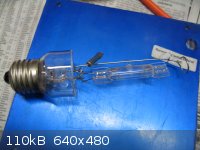
I built a small elliptical enclosure from a 2 foot section of galvanized 6 inch steel duct. This was covered on the inside with aluminum foil. The
mogul lamp base and 1000mL chlorination RBF were placed at the foci, 4 inches center-to-center separation. Both experiments were conducted using this
enclosure. This enclosure is shown below:
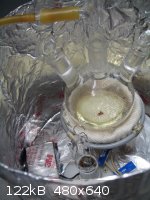
The picture below shows the lamp in operation during the 1st experiment. The 2nd experiment would look the same except I covered the enclosure with a
sheet of aluminum foil.
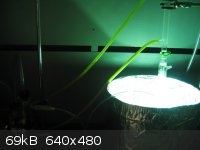
The chlorine was generated with TCCA and 20% HCl as described in Prepublication. For each experiment I used 2 ea batches of 55g of TCCA and 196mL of
20% HCl. In each case I used the following Cl2 drying train between the Cl2 generator and the reactor: CaCl2 drying, safety bottle, con H2SO4
drying. A sparge tube with porous frit end was used to inject the Cl2 into the chloroform. A reflux condenser was used at the reactor which was
heated with an electic mantle. Gases passing the reflux condenser (Cl2, HCl) were led to an inverted funnel over 10% NaOH for absorbtion of the HCl.
The chlorine generator is shown here:
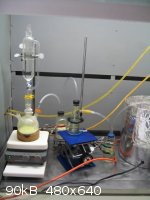
Following each of the two runs the product was fractionated using a column consisting of a 200mm West condenser stacked above a 200mm Hempel column.
The Hempel column was packed with glass shards, the West condenser with a ss scrub pad. A Hennion still head was used to control the reflux ratio.
The 2 pictures below show this apparatus:
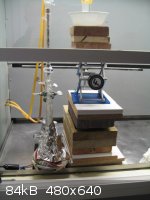
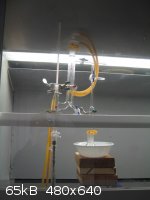
Results & Conclusions The yield from the 1st experiment was zero. The charge came over as pure chloroform, bp 61.2 °C.
The yield from the 2nd experiment was a disappointing 9.4 mL, coming over at 76.7 °C. An intermediate cut of 37mL of distillate in the bp range of
61.2-76.7°C was obtained, however. This conceivably could contain another 18mL of CCl4.
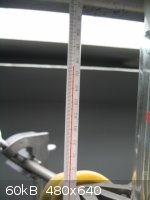
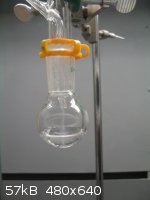
Beefing up the UV wattage to 0.4kW and procurement of a 600mm Hempel column are in progress. More experiments will be conducted and I will post the
results.
As usual, questions, comments, and suggestions are welcomed.
[Edited on 7-11-2013 by Magpie]
The single most important condition for a successful synthesis is good mixing - Nicodem
|
|
|
deltaH
Dangerous source of unreferenced speculation
    
Posts: 1663
Registered: 30-9-2013
Location: South Africa
Member Is Offline
Mood: Heavily protonated
|
|
Hi Magpie, wonderful and courageous effort! I think I know what went wrong, as you rightly pointed out glass absorbs UV, your
RB-flask is made of borosilicate glass!
I suggest getting a hold of a fused quartz tube that is sealed at the one end (like a test tube shape) that can fit through one of the openings of
your RBF as a 'immersed finger' into the middle of the liquid pool. Into this you place your UV bulb (it will be dry and on the inside of your quartz
finger). The heat produced by the bulb will simply boil the chloroform and be carried away by the cooling water in the condenser, so no problem. Make
sure the hot part of the 'finger' (at least the length of the bulb) is completely immersed by liquid so that hot spots don't develop... it's just good
practice (a fully immersed finger absorbs more UV, reduces side reactions of vapours on the hot spot, etc.)
Ensure you fit a good condenser and have a reliable water flow!
[Edited on 7-11-2013 by deltaH]
|
|
|
bfesser
Resident Wikipedian
    
Posts: 2114
Registered: 29-1-2008
Member Is Offline
Mood: No Mood
|
|
Very impressive, Magpie! If you're in need of quartz reaction chambers, similar HID lamps may be a possible source, as I <a
href="viewthread.php?tid=19214#pid240805" target="_blank">mentioned in another thread</a></strong>. I look foward to reading of
further progress on this. Keep up the great work, and please stay safe around those strong UV sources! I used to wear IR/UV protective eye-wear just
to change those lamps when they were partially illuminated <em>and intact</em>.
|
|
|
Magpie
lab constructor
    
Posts: 5939
Registered: 1-11-2003
Location: USA
Member Is Offline
Mood: Chemistry: the subtle science.
|
|
Quote: Originally posted by deltaH  | Hi Magpie, wonderful and courageous effort! I think I know what went wrong, as you rightly pointed out glass absorbs UV, your
RB-flask is made of borosilicate glass!
|
Thank you. Len accepted the absorbtion of 50% of wavelength 310nm for the estimated 2mm thick borosilicate 1000mL RBF reactor and still had quite
satisfactory results. I'm not planning on scaling up to a 1kW lamp (I've got too much money in this project already). So if I can get 50% conversion
or better with 0.4kW I will be satisfied. I realize that this approach places a big burden on my fractional distillation capability. But I've been
wanting to enhance this capability anyway as it has general utility.
Quote: Originally posted by deltaH  |
I suggest getting a hold of a fused quartz tube that is sealed at the one end (like a test tube shape) that can fit through one of the openings of
your RBF as a 'immersed finger' into the middle of the liquid pool. Into this you place your UV bulb (it will be dry and on the inside of your quartz
finger). The heat produced by the bulb will simply boil the chloroform and be carried away by the cooling water in the condenser, so no problem. Make
sure the hot part of the 'finger' (at least the length of the bulb) is completely immersed by liquid so that hot spots don't develop... it's just good
practice (a fully immersed finger absorbs more UV, reduces side reactions of vapours on the hot spot, etc.)
|
If I could find the right quartz tube I might experiment with this idea. Or I could just order the equipment from Ace Glass - $2000 ought to do it
for a complete set-up! 
[Edited on 7-11-2013 by Magpie]
The single most important condition for a successful synthesis is good mixing - Nicodem
|
|
|
deltaH
Dangerous source of unreferenced speculation
    
Posts: 1663
Registered: 30-9-2013
Location: South Africa
Member Is Offline
Mood: Heavily protonated
|
|
| Quote: | If I could find the right quartz tube I might experiment with this idea. Or I could just order the equipment from Ace Glass - $2000 ought to do it for
a complete set-up!  |
Ah Ace glassware...
you gotta 'love' them lol
I wish you best of luck!
|
|
|
Magpie
lab constructor
    
Posts: 5939
Registered: 1-11-2003
Location: USA
Member Is Offline
Mood: Chemistry: the subtle science.
|
|
Here's a couple pictures on my progress toward making CCl4 more effectively.
The 600mm Hempel column arrived and was successfully tested with a 50/50 v/v% heptane/toluene mixture having a boiling point spread of 19-20°C.
Packing was ss scrub pad. Hardware store nominal 1/2"ID foam pipe insulation was used to help maintain an adiabatic column temperature: Column ID is
12.7mm.
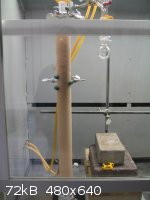
[Hempel column]
The 0.4kW mercury vapor lamp was wired to its ballast and tested today as shown. I haven't removed the borosilicate protective envelope yet.
Mercury vapor lamp ballasts have been banned from production in the US since 2008. Fortunately they are still available on eBay, for now. Lamps can
still be bought through regular stores and on-line, for now.
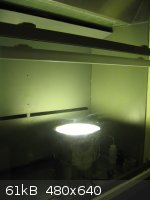
[0.4kW MV lamp]
[Edited on 14-11-2013 by Magpie]
The single most important condition for a successful synthesis is good mixing - Nicodem
|
|
|
Magpie
lab constructor
    
Posts: 5939
Registered: 1-11-2003
Location: USA
Member Is Offline
Mood: Chemistry: the subtle science.
|
|
Yesterday I fractionated the product from my latest run at making CCl4 from CHCl3. This run (#3) utilized the 0.4kW Hg vapor lamp as improvement over
the previous run (#2) using a 0.1kW Hg vapor lamp. Again I used a 100mL charge of CHCl3. In reviewing my calculations, however, I found that for run
#2 I inadvertantly used too little Cl2. I used 110g of TCCA for #2; for #3 I used a corrected amount, 200g. This gives Len1's recommended 2X
stoichiometric Cl2.
The yield was 49mL, or 40.9% based on the CHCl3 charged. This is considerably better than the yield of run#2, ie, 9.4 mL.
Even with my new 600mm Hempel column the fractionation is a difficult one. Initially the CHCl3 comes off at its bp of 61.2°C for about 25-30mL.
Then the temperature slowly rises to the bp of CCl4, 76.7°C. The transition volume is about 15mL. I took this transition very slowly, ~2 hours,
keeping a low boilup rate and a high reflux ratio, ~10:1.
I started taking product (CCl4) when the still head temperature reached 76°C.
One of my goals with this synthesis was to acquire equipment for and develop skill in doing, difficult (or challenging) fractional distillations. I
believe I'm still on the learning curve.
Questions, comments, recommendations are welcomed.
The single most important condition for a successful synthesis is good mixing - Nicodem
|
|
|
zenosx
Hazard to Others
  
Posts: 188
Registered: 7-7-2012
Location: East TN / Near Oak Ridge
Member Is Offline
Mood: Awaiting Results....
|
|
Awesome Job Magpie... jealous of your Hennion apparatus....Wish I had more time and/or $ to put to my hobby....
A question that sometimes drives me hazy: am I or are the others crazy?
Albert Einstein
|
|
|
Magpie
lab constructor
    
Posts: 5939
Registered: 1-11-2003
Location: USA
Member Is Offline
Mood: Chemistry: the subtle science.
|
|
Thank you zenosx. Indeed this project took time and money, luxuries I now have in my retirement. I did get a real bargain on the 0.4kW ballast on
eBay: $35 + free shipping - important as it must weigh about 10 lbs. For comparison, a local grow shop is charging around $190 for same. An
electronic ballast is even more expensive but it has the option for several different watt levels up to 1kW.
I'm considering doing other free radical chlorinations. About the only change I would make to my apparatus is to lower the lamp 3" so that it shines
more directly on the 1000mL RBF.
Oh, and I should mention that without the deep discount of Dr Bob I might never have bought the Hennion still head.
[Edited on 2-12-2013 by Magpie]
The single most important condition for a successful synthesis is good mixing - Nicodem
|
|
|
Magpie
lab constructor
    
Posts: 5939
Registered: 1-11-2003
Location: USA
Member Is Offline
Mood: Chemistry: the subtle science.
|
|
I made another production run for CCl4 from chloroform and thought I should post the results. It was done the same way as my previous run described
above.
Again my charge was 100mL chloroform. The chlorine was generated from 2ea 100g batches of TCCA, double the stoichiometric amount. My uv source was
an unshielded 400w mercury street lamp.
This preparation, although successful, was a major PITA for the following reasons:
1. Gaseous chlorine is just nasty and I can't seem to avoid inhaling some, especially during cleanup.
2. Cl2 reacts with the silicone grease I use at tapered glass joints and the product is a pain to remove.
3. Any wayward Cl2 reacts with my metal clamps and my ss hood floor. The rust requires scrubbing with a 3M pad to remove.
4. Because I have trouble maintaining a 0.5 drop/s addition rate of the 20%HCl it takes me 5-6 hr to add the Cl2 for each of the two batches of TCCA.
I did get, apparently, a very good product, however, as I didn't detect any unreacted chloroform, ie, no low boiling material, even with my 600mm
Hempel column fractionation. Therefore, I believe this PITA could be avoided and just a simple distillation used instead. At most a short
200mm fractionation column should suffice.
The pot residue was ~10mL of liquid, brown from some slight charing. As I emptied the pot I noticed a small amount of dense, translucent white
crystals. At first I didn't know what this could be. Upon rereading Len1's book I learned that it was C2Cl6, hexachloroethane, produced at 0.1%.
Normally I don't whine about the difficulties in doing a preparation. But in this case, unless you just love it, Elemental Scientific might be the
smart way to go. 
[Edited on 26-10-2014 by Magpie]
[Edited on 26-10-2014 by Magpie]
The single most important condition for a successful synthesis is good mixing - Nicodem
|
|
|
UnintentionalChaos
International Hazard
    
Posts: 1454
Registered: 9-12-2006
Location: Mars
Member Is Offline
Mood: Nucleophilic
|
|
Nice work, Magpie!
I too, have experienced the 'joy' of halogenated grease from both chlorinations and brominations. Aside from the painful price, I wonder if a small
amount of Krytox grease is worth investing in for these specific applications. The stuff is impervious as it is a perfluoropolyether.
Department of Redundancy Department - Now with paperwork!
'In organic synthesis, we call decomposition products "crap", however this is not a IUPAC approved nomenclature.' -Nicodem
|
|
|
Oscilllator
National Hazard
   
Posts: 659
Registered: 8-10-2012
Location: The aqueous layer
Member Is Offline
Mood: No Mood
|
|
Quote: Originally posted by Magpie  |
2. Cl2 reacts with the silicone grease I use at tapered glass joints and the product is a pain to remove.
[Edited on 26-10-2014 by Magpie] |
So thats where that horrible gunk on the inside of my ground glass joints came from! I was wondering about that...
Nice work though Magpie! Another experiment to add to the list of things I can do once I get a UV lamp.
|
|
|
hyfalcon
International Hazard
    
Posts: 1003
Registered: 29-3-2012
Member Is Offline
Mood: No Mood
|
|
I bet this would come in handy for this project.
http://www.ebay.com/itm/ACE-Glass-250mL-4-Neck-Jacket-Photoc...
|
|
|
Magpie
lab constructor
    
Posts: 5939
Registered: 1-11-2003
Location: USA
Member Is Offline
Mood: Chemistry: the subtle science.
|
|
Quote: Originally posted by UnintentionalChaos  |
I too, have experienced the 'joy' of halogenated grease from both chlorinations and brominations. Aside from the painful price, I wonder if a small
amount of Krytox grease is worth investing in for these specific applications. The stuff is impervious as it is a perfluoropolyether.
|
I bought a 0.5 oz tube of Krytox which I plan on using for an upcoming chlorination. We'll see how it seals, and if it prevents the white sticky crud
from forming.
[Edited on 7-2-2015 by Magpie]
The single most important condition for a successful synthesis is good mixing - Nicodem
|
|
|
j_sum1
Administrator
       
Posts: 6372
Registered: 4-10-2014
Location: At home
Member Is Offline
Mood: Most of the ducks are in a row
|
|
I have had a request to move this from beginnings.
I hesitate to put it in prepub since the write-up by Magpie is not the OP and is following a procedure already published.
But, topically, it fits in prepublication better than elsewhere. So, for the ease of those searching, I will move it.
Good luck to all who are after some CCl4.
J.
|
|
|
j_sum1
|
Thread Moved
21-4-2019 at 05:14 |
| Pages:
1
2 |